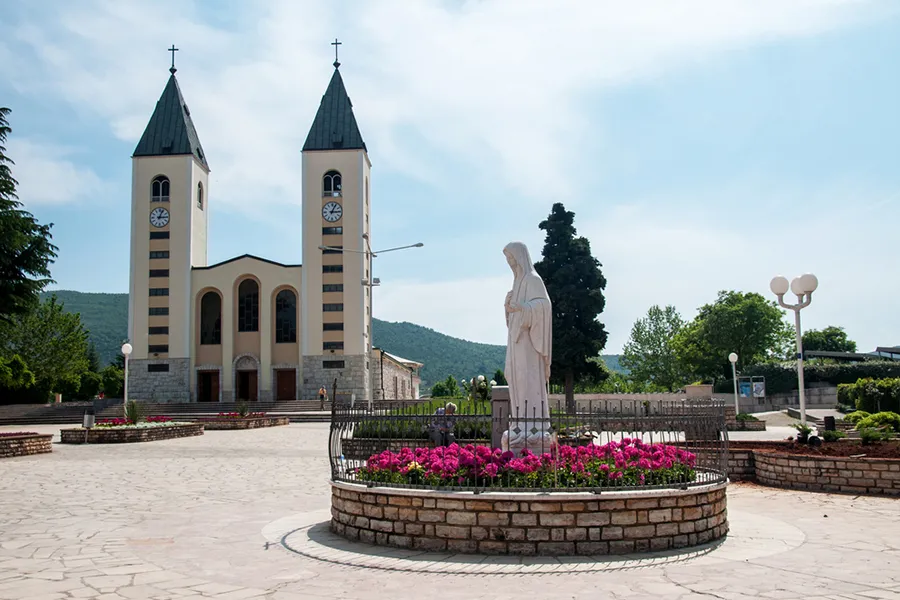
Medjugorje, Bosnia-Herzegovina, Jul 23, 2018 / 10:25 am (CNA/EWTN News).- The Vatican’s apostolic visitor to Medjugorje, appointed by the pope to oversee the pastoral needs at the site of alleged Marian apparitions, began his mandate Sunday.
Archbishop Henryk Hoser, retired archbishop of Warsaw-Prague, celebrated Mass at St. James church in Medjugorje July 22 to mark the beginning of the directive, which follows his service as papal envoy to the site in 2017.
In his homily at Mass, the apostolic visitor said that “the fundamental question” about Medjugorje is why so many people go there every year, and said the answer is that they go “to meet someone: to meet God, to meet Christ, to meet His Mother.”
He pointed to Lumen gentium, a document from the Second Vatican Council, which emphasizes that Marian devotion is approved and encouraged by the Church as it develops “in harmonic subordination” to worship of Christ, which he said the popular devotion at Medjugorje achieves.
“Holy Mass, the adoration of the Blessed Sacrament, a massive frequency of the Sacrament of Penance, accompanied by other forms of piety: The Rosary and the Way of the Cross,” are all at the center of the site’s devotion to the Blessed Virgin Mary, he said.
Quoting the day’s first reading from the prophet Jeremiah, he said, “‘Woe to the shepherds who mislead and scatter the flock of my pasture.’ The Holy Father, the universal pastor of the Church, takes these words of the prophet as his own. He sends us there, where the people exist and live, where the faithful gather to seek the light of salvation.”
The archbishop did not comment on the validity of the alleged apparitions.
Hoser’s appointment as apostolic visitor was announced May 31 as an “exclusively pastoral” role. It is for an undetermined length of time and will continue “at the desire of the Holy See.”
According to the Vatican’s press release May 31, the assignment is to ensure “a stable and continuous accompaniment” of the parish community and of pilgrims who visit the shrine “whose needs require special attention.” Archbishop Hoser stressed that he was not tasked with anything beyond this scope.
In January 2014, a Vatican commission concluded a nearly four-year-long investigation on the doctrinal and disciplinary aspects of the Medjugorje apparitions, and submitted a document to the Congregation for the Doctrine of the Faith.
When the congregation has analyzed the commission’s findings, it will finalize a document on the site, which will be submitted to the pope, who will make a final decision.
The alleged apparitions began June 24, 1981, when six children in Medjugorje, a town in what is now Bosnia and Herzegovina, began to experience phenomena which they have claimed to be apparitions of the Blessed Virgin Mary.
According to these six “seers,” the apparitions contained a message of peace for the world, a call to conversion, prayer and fasting, as well as certain secrets surrounding events to be fulfilled in the future.
These apparitions are said to have continued almost daily since their first occurrence, with three of the original six children – who are now young adults – continuing to receive apparitions every afternoon because not all the “secrets” intended for them have been revealed.
Since their beginning, the alleged apparitions have been a source of both controversy and conversion, with many flocking to the city for pilgrimage and prayer, and some claiming to have experienced miracles at the site, while many others claim the visions are non-credible.
Pope Francis visited Bosnia and Herzegovina in June 2015 but declined to stop in Medjugorje during his trip. During his return flight to Rome, he indicated that the process of investigation in the apparitions was nearly complete.
On the return flight from a visit to the Marian shrine of Fatima in May 2017, the pope spoke about the final document of the Medjugorje commission, sometimes referred to as the “Ruini report,” after the head of the commission, Cardinal Camillo Ruini, calling it “very, very good,” and noting a distinction between the first Marian apparitions at Medjugorje and the later ones.
“The first apparitions, which were to children, the report more or less says that these need to continue being studied,” he said, but as for “presumed current apparitions, the report has its doubts,” the pope said.
On multiple occasions, the pope has said he is suspicious of the ongoing apparitions, “I prefer the Madonna as Mother, our Mother, and not a woman who’s the head of an office, who every day sends a message at a certain hour. This is not the Mother of Jesus.”
If you value the news and views Catholic World Report provides, please consider donating to support our efforts. Your contribution will help us continue to make CWR available to all readers worldwide for free, without a subscription. Thank you for your generosity!
Click here for more information on donating to CWR. Click here to sign up for our newsletter.



Where were the visionaries at this mass?